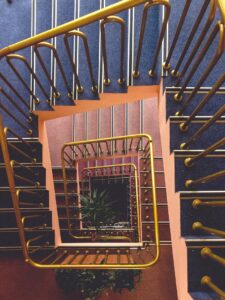During stormy or winter weather, stairs, which are always at least a little tricky, become extra treacherous. This is when handrails become even more important. Unfortunately, time and weather can take a toll on the finish and durability of most outdoor railings, especially painted ones. Even steel handrails will show wear from the weather, everyday use, and extreme abuse (like close encounters with skateboards). Architectural bronze, which is actually brass since it is zinc alloy, is an extremely low-maintenance specialty metal. Durable brass handrails continue to be a beautiful and sturdy railing for decades. If you’re considering brass specialty metal railings, here are some things to keep in mind.
Shapes
Brass for handrails is usually an alloy of 60% copper and 40% zinc, which makes for an easily extruded martial that comes in a variety of shapes. Brass handrails often include a combination of channels and flat bars. These allow for graspability on the top surface, along with concealed fasteners on the undersurface. Brass handrails are usually no more than 2.25″ wide in profile unless they are installed on substrates as a perimeter or circumference. These are often no more than 4″-6″ wide. Whatever the width, they have to be installed at least 1.5″ from the wall, and the handrails have to extend 12″ beyond the first and last riser. Outside of these requirements, you can achieve any number of unique decorative looks with brass.
Posts And Brackets
The posts or brackets that support the bronze specialty metal handrail see wear and tear less often. Brackets of steel instead of brass will save money, but the posts of a different material would be visibly noticeable. Bronze posts of 1.5″ diameter (or 1.25″ diameter for residential) should be solid or reinforced if they are hollow. Finally, posts or brackets should be less than 48″ apart to prevent sagging and noticeable give to the railing. Keep in mind that any water that seeps into a hollow post could collect there and cause issues.
Joinery
Often the decorative elements, like scroll ends, need to be joined to the extruded handrail body. These joinery connections will become noticeable and unsightly if they aren’t done well. Welds should be hidden and kept to a minimum as much as possible.
Texture And Patina
One of the final steps will be to add a mechanical finish to the brass before any color or patina is applied. Most often this is a satin finish, which is achieved with a linear grain or sandblasting. For a polished brass finish, the handrail will need even more refining and time, and the costs will be higher. After achieving the texture and grain, chemical patina solutions can be applied to change the color of the metal, then buffed back to reveal the characteristics of the brass beneath.
HAVE QUESTIONS? ASK HERCULES CUSTOM IRON
If you are ready to install your massive duty iron fence and add iron railings or you still have some more questions, we here at Hercules Custom Iron are here to help. We have many years of experience and will ensure that your chain link fence will serve you and your family for years. Visit us online or call us at 1-800-331-2590. For advice, updates, and to see what we are up to, be sure to follow us on social media on Facebook, Twitter, LinkedIn, YouTube, and Pinterest.


